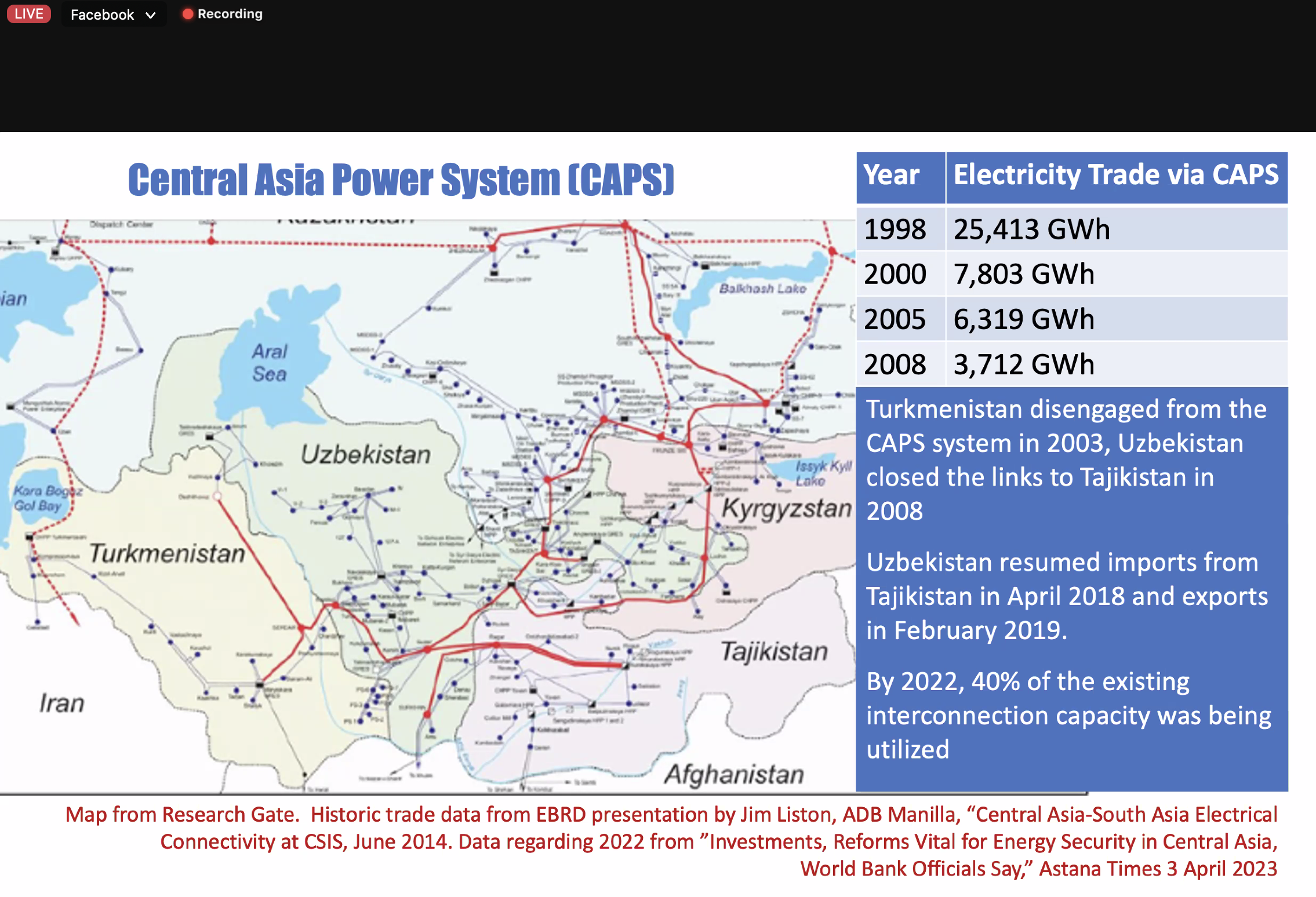An International Expert Meeting entitled “Unlocking Central Asia’s Infrastructure and Energy Potential” was organised by the IWPR Central Asia office in early August.

According to the organisers, the main goal of this expert discussion is to address the slow progress and challenges hindering infrastructure and energy project development. Today, we have a brilliant panel of experts who will explore justification strategies, reducing dependence on external powers, and opportunities for regional cooperation in energy and infrastructure development.
The moderator Mr. Eldaniz Guseinov, a European and international studies specialist at the Heartland Expert Analytical Center stated that Central Asia has great potential to become a key player on the global energy infrastructure map.
“However, before we unlock this potential, it is crucial to address various economic, geopolitical, and environmental factors that shape the region’s energy and logistics landscape. By harnessing this potential effectively, we can usher in a new era of economic growth, regional stability, and sustainable development,” Guseynov said.
Dr. Theresa Sabonis-Helf, the first chair of the Department of Science, Technology and International Affairs in the Master’s Program at Georgetown University School of Business, noted that Central Asia is currently facing a second energy transition.

“The memory of the previous energy transition, caused by the collapse of the Soviet Union, still looms large. In fact, that transition, which aimed to establish a meaningful price for electricity and transform it into a self-sustaining sector, remains incomplete,” said Dr Theresa Sabonis-Helf.
According to her, every country in the region now has more installed capacity and a greater ability to generate electricity than in 1991.
As of 2020, the price of electricity in most Central Asian countries has approached cost recovery
“However, there are two significant causes for concern when we analyze this information. Firstly, the per capita consumption of electricity in Central Asia is still lower than the average of developed countries.”
Additionally, every country anticipates a surge in demand. In fact, the Asian Development Bank projects that by 2030, energy demand in the region will increase by 30 per cent, with a majority of that growth occurring in the realm of electricity.
This combination of factors, encompassing both increased demand and the growing unreliability of supply from hydroelectric sources, has led to a complex challenge. Historically, the power system in Central Asia was designed to strike a balance by employing various energy sources according to the seasons.
During the Soviet era, regional trade and electricity exchange were orchestrated to utilize more hydropower from Kyrgyzstan and Tajikistan during times of abundant water availability, while the winter months saw the utilization of fossil fuel resources concentrated in Kazakhstan, Uzbekistan, and Turkmenistan for heating and lighting purposes.
Nonetheless, the power system started to deteriorate in 2000, was shut down in 2008, and was not fully reinstated until 2018.
Currently, according to Theresa Sabonis-Helf, only about 40 per cent of the available capacity in the region is being utilised.
“Firstly, it is imperative that we contemplate the role of nuclear fuel and power plants in shaping the future of Central Asian electricity demand amidst declining carbon footprints,” says Theresa Sabonis-Helf.
The potential for nuclear power deserves consideration, particularly given Kazakhstan and Uzbekistan’s substantial uranium reserves.
Theresa Sabonis-Helf also suggested drawing attention to the need for effective regulation and governance of energy-intensive sectors such as bitcoin, given China’s total ban on cryptocurrencies.
Effectively regulating and managing such energy-demanding sectors, like Bitcoin, is pivotal for a well-functioning regional energy system.
Dr. Farhod Aminjonov, a professor at the National Defence College of Abu Dhabi said that the capacity of the Central Asian energy system is relatively limited for three reasons: inadequate planning, limited involvement of local countries and an unattractive business climate.
“Having looked at projects over the past couple of decades, I noticed that the most successful ones are actually those in which the local actors’ involvement is limited,” Farhod Aminjonov said.
According to him, projects where local partners took the lead were very unsuccessful.
He questioned whether the Central Asian countries would be able to improve the investment climate in the short to medium term.
“Perhaps we need to think about how to work in the environment of a relatively bad business climate,” said Farhod Aminjonov.
“Just look at the data numbers. Kazakhstan is way ahead of others and it’s been doing a great job. But for the most part, the technology and expertise required for diversification often come from external sources,” Farhod Aminjonov said, adding that in fact most renewable energy facilities are built by foreign investors.
He mentioned the example of Uzbekistan, where agreements worth tens of billions of dollars have been signed with Gulf countries on the construction of solar and wind energy facilities.
“It’s very important that Central Asian countries develop a comprehensive roadmap of what needs to be done,” believes Farhod Aminjonov.
At the same time, he said, countries should not use a one-size-fits-all strategy.
“Because if you look at what is written right now, and compare studies done for Uzbekistan, Kazakhstan, and Tajikistan, they are all the same recommendations… I think, in a Central Asian context, separate roadmaps have to be developed for each country specifically,” said Farhod Aminjonov
Second, according to him, feasible plans for energy transition and modernisation of energy infrastructure need to be developed.
Farhod Aminjonov also questioned whether Uzbekistan’s ambition to increase the share of renewable energy sources in the total energy balance to 8 gigawatts by 2030 could be achieved.
“Third, work with inconvenient partners on inconvenient projects,” Farhod Aminjonov suggests.
According to him, the region is often tempted by easy loans from foreign partners who promise to build everything at a very low cost.
“I would probably try to at least consider seriously some projects being offered by European partners on a large scale. They might be a little bit more expensive, but perhaps in the longer run, it will pay off,” believes Farhod Aminjonov.
Farhod Aminjonov also emphasised that it is vital to gain the trust of the public. If people realise that the government, in partnership with the private sector and multilateral institutions, is doing its best to address energy security issues, “they will put up with short-term challenges for the sake of long-term prosperity and energy security”.
Przemyslaw Ozerski, an expert of the Central Asian Strategic Center for Analysis, Dialogue and Development, spoke about the challenges and advantages of developing transport corridors in Central Asia.
The disruptions caused by the COVID-19 pandemic have had a profound impact on logistical flows between Central Asian states and the rest of the world, he said.
The situation escalated further with the crisis in transporting goods through Europe in January 2022, catalyzed by events in Kazakhstan. Subsequently, the Ukrainian-Russian conflict introduced a fresh layer of complexity, ushering in issues related to sanctions and their impact on supply chains.
The Global Supply Chain crisis prompted Central Asia to seek alternative routes for supplies and transit. These alternative routes aimed to bypass Russia and reduce dependency. While the initial shift was toward the North, Central Asia soon shifted its focus to the South, particularly the Middle Corridor. This corridor traverses controversial territories, passing through Pakistan and Turkmenistan and utilizing the Caspian Sea route to reach the Caucasus and Turkey.
Central Asian countries are actively pursuing new routes in an attempt to gain access to Iranian and Arab Gulf ports.
“The emergence of new southern transport routes means a shift of interests, although not completely detached from Russian influence,” said Przemislav Ozerski.
He suggests that while conflicts may persist for five or ten years, it is expected that there will eventually be an economic restart and normalisation of business services.
“This strategic move holds significance, as it demonstrates Central Asia’s integration into the global supply chain. By establishing connectivity to these ports, the region showcases its ability to contribute to the global market and emphasizes its right to do so. This development, in turn, will stimulate the growth of these countries, addressing the challenge of energy infrastructure development,” noted Przemislav Ozerski.
Roman Vakulchuk, head of the Climate and Energy Research Group at the Norwegian Institute of International Affairs, highlighted three specific points that are relevant to Central Asia’s strategic orientation in achieving decarbonisation.
According to him, there has been a consistent annual increase in the use of alternative energy sources by about one per cent in the energy mix.
While this progress is noteworthy, the challenge lies in addressing urbanization. Many communities, especially those reliant solely on fossil fuels like coal, face risks. This is particularly evident in remote areas of Kazakhstan, including the so-called Mono cities, where coal is a primary industry. These areas host two to four hundred thousand people employed in and servicing the coal industry. Therefore, policymakers should prioritize addressing this challenge in their decarbonization and renewable energy strategies.
“My second point emphasizes the need for a robust strategic vision for infrastructure investment in the region,” said Roman Vakulchuk.
He recalled that infrastructure can be categorized as either hard or soft. Hard infrastructure includes physical assets like roads and bridges, while soft infrastructure refers to investments in human capital. For Central Asia, it is imperative to expedite and advance investments in digital infrastructure.
This domain offers a considerable comparative advantage, especially considering the region’s expansive territory and relatively accessible land. Kazakhstan and Uzbekistan, for instance, possess well-developed hard infrastructure, making them prime candidates for digital infrastructure expansion.
Roman Vakulchuk questioned why aren’t major investors like China redirecting significant investments into digital infrastructure for renewable energy, similar to their endeavors in Southeast Asian countries such as Vietnam and Indonesia?
“This brings me to my third point regarding strategic visioning. Stakeholders across Central Asia must shift their perspective and compare the region not merely with neighboring countries, but with global success stories,” Roman Vakulchuk noted.
According to him international investors seek unique value propositions in any market they explore. Hence, it becomes crucial to discern what sets Kazakhstan, Kyrgyzstan, and other Central Asian nations apart from the world’s most successful countries.
“Countries like Vietnam, Australia, and others in Southeast Asia have managed to attract substantial multi-billion-dollar investments annually into renewable energy infrastructure. Understanding and leveraging these successful models can inspire and guide Central Asia’s journey toward sustainable energy transformation”, believes Roman Vakulchuk.
At the end of the meeting, the experts took questions from the audience.
Main photo: www.vsemirnyjbank.org

